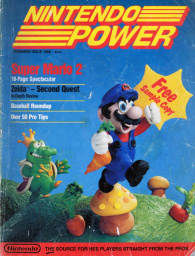Difference between revisions of "Nintendo Power"
| Line 6: | Line 6: | ||
I adored Nintendo Power in the late 1980s and early 1990s because it offered video game information that was otherwise unavailable to us pre-Internet kids. Since my parents would never buy me a video game magazine, I had to rely on reading copies from friends, or viewing them in my school's library. While I would make hand-drawn copies from them, my older brother would just rip out the pages for the games we owned. I stopped caring about Nintendo Power around the time the [[Nintendo 64]] came out. | I adored Nintendo Power in the late 1980s and early 1990s because it offered video game information that was otherwise unavailable to us pre-Internet kids. Since my parents would never buy me a video game magazine, I had to rely on reading copies from friends, or viewing them in my school's library. While I would make hand-drawn copies from them, my older brother would just rip out the pages for the games we owned. I stopped caring about Nintendo Power around the time the [[Nintendo 64]] came out. | ||
| + | |||
| + | ==Review== | ||
| + | ===Good=== | ||
| + | * Each issue contained a wealth of information that you couldn't find anywhere else on dozens of games. | ||
| + | * The artists created attractive cartoons, photos, paintings, and dioramas of various games. | ||
| + | * The Top-30 section was pretty trust worthy, and the top 10 was pretty much always filled with quality games. | ||
| + | * The magazine also published letters to the editor and player's high scores. | ||
| + | * To keep things interesting, the magazine talked about other issues popular to kids and teens like celebrities, theme parks, and television shows. | ||
| + | |||
| + | ===Bad=== | ||
| + | * Probably due to the magazine's tight schedule, sometimes terrible games would get several pages devoted to them. This would hype kids up for a huge let down. For example, the third issue spent 14 pages on [[Track & Field II]]. | ||
| + | |||
| + | ===Ugly=== | ||
| + | * Nothing. | ||
==Page Scans== | ==Page Scans== | ||
Revision as of 17:35, 20 February 2018
Nintendo Power was a video game magazine published by Nintendo from 1988 to 2012 with a total of 285 printed magazines. It began as a bi-monthy publication, but switched to monthly starting with the May 1990 issue. It is one of the longest running video game magazines in the Western world.
Each magazine included in-depth segments on a couple games, but also several recurring segments like "Counselor's Corner," which answered reader's gaming questions, "Classified Information," which usually contained cheats and secrets, "Howard & Nester," a comic which always gave a game hint, "Pak Watch," which talked about the upcoming games, the "Top 30," which ranked the most popular games (Nintendo's own always made the most appearances).
I adored Nintendo Power in the late 1980s and early 1990s because it offered video game information that was otherwise unavailable to us pre-Internet kids. Since my parents would never buy me a video game magazine, I had to rely on reading copies from friends, or viewing them in my school's library. While I would make hand-drawn copies from them, my older brother would just rip out the pages for the games we owned. I stopped caring about Nintendo Power around the time the Nintendo 64 came out.
Review
Good
- Each issue contained a wealth of information that you couldn't find anywhere else on dozens of games.
- The artists created attractive cartoons, photos, paintings, and dioramas of various games.
- The Top-30 section was pretty trust worthy, and the top 10 was pretty much always filled with quality games.
- The magazine also published letters to the editor and player's high scores.
- To keep things interesting, the magazine talked about other issues popular to kids and teens like celebrities, theme parks, and television shows.
Bad
- Probably due to the magazine's tight schedule, sometimes terrible games would get several pages devoted to them. This would hype kids up for a huge let down. For example, the third issue spent 14 pages on Track & Field II.
Ugly
- Nothing.
Page Scans
Secondary Magazines
Nintendo Power released several additional magazines which either focused on a single game or covered all the upcoming games for a new system. These magazines included:
- The Official Nintendo Player's Guide
- Tips & Tactics: The Legend of Zelda - Instruction Booklet
- Nintendo Power Strategy Guide: 4-Player Extra
- Nintendo Power Strategy Guide: Final Fantasy
- Nintendo Power Strategy Guide: Dragon Warrior
- Nintendo Power Strategy Guide: Ninja Gaiden II
- Nintendo Power Strategy Guide: Super Mario Bros. 3
- Nintendo Player's Guide: Earthbound
- Nintendo Player's Guide: The Legend of Zelda: A Link to the Past
- Nintendo Player's Guide: Mario Mania
- Nintendo Player's Guide: NES Game Atlas
- Nintendo Player's Guide: Pokemon
- Nintendo Player's Guide: Super Game Boy
- Nintendo Player's Guide: Super Mario Bros. All Stars
- Nintendo Player's Guide: Super Metroid
- Nintendo Player's Guide: Super NES
Links
- en.wikipedia.org/wiki/Nintendo_Power - Wikipedia.
